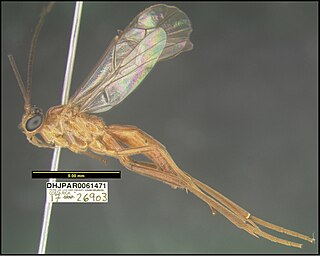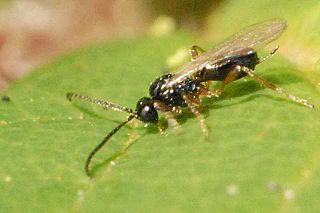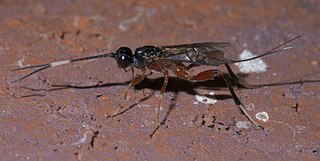
The superfamily Ichneumonoidea contains one extinct and three extant families, including the two largest families within Hymenoptera: Ichneumonidae and Braconidae. The group is thought to contain as many as 100,000 species, many of which have not yet been described. Like other parasitoid wasps, they were long placed in the "Parasitica", variously considered as an infraorder or an unranked clade, now known to be paraphyletic.

The Ichneumonidae, also known as ichneumon wasps, ichneumonid wasps, ichneumonids, or Darwin wasps, are a family of parasitoid wasps of the insect order Hymenoptera. They are one of the most diverse groups within the Hymenoptera with roughly 25,000 species described as of 2016. However, this likely represents less than a quarter of their true richness as reliable estimates are lacking, along with much of the most basic knowledge about their ecology, distribution, and evolution. It is estimated that there are more species in this family than there are species of birds and mammals combined. Ichneumonid wasps, with very few exceptions, attack the immature stages of holometabolous insects and spiders, eventually killing their hosts. They thus fulfill an important role as regulators of insect populations, both in natural and semi-natural systems, making them promising agents for biological control.

The Braconidae are a family of parasitoid wasps. After the closely related Ichneumonidae, braconids make up the second-largest family in the order Hymenoptera, with about 17,000 recognized species and many thousands more undescribed. One analysis estimated a total between 30,000 and 50,000, and another provided a narrower estimate between 42,000 and 43,000 species.
Araucania is an invalid genus of braconid wasps in the family Braconidae, found in South America. There are at least two described species in Araucania.

Microgastrinae is a subfamily of braconid wasps, encompassing almost 3,000 described species, with an estimated 30,000–50,000 total species. This makes it one of the richest subfamilies with the most species of parasitoid wasps.

Apanteles is a very large genus of braconid wasps, containing more than 600 described species found worldwide. There are no native species in New Zealand, and none have been recorded in the high arctic.

Bracon is a genus of wasps in the Braconidae, a family of parasitoid wasps. There are several hundred described species but there are thousands still undescribed. The genus is cosmopolitan, distributed throughout the world, with most of the described species occurring in the Palearctic realm.
Apozyx is a genus of braconid parasitic wasps with only one species, Apozyx penyai. It is the only genus in the subfamily Apozyginae. This subfamily was originally proposed as a separate family by Mason in 1978.

The Homolobinae are a subfamily of braconid parasitoid wasps.
Dirrhope is the only extant genus in the subfamily Dirrhopinae of braconid parasitoid wasps. Dirrope was included in the Microgastrinae until 1984. Specimens of this genus have been found fossilsed in amber dating from the Cretaceous period.

Blacini is a tribe of braconid Parasitoid wasps. Formerly the subfamily Blacinae, this group was demoted to a tribe and placed within the Brachistinae based on molecular evidence in 2011.

Meteorinae is a subfamily of braconid parasitoid wasps; however, since 2015, most scientists have treated this clade as the Tribe Meteorini in Euphorinae. Several species have been used in biological control programs. The name for this group comes from the pupal stage, which, in species attacking Lepidopteran hosts, hangs suspended from a long thread of silk.

Microplitis is a genus of braconid wasps in the family Braconidae. There are more than 190 described species in Microplitis, found throughout the world.

Helconinae is a subfamily of braconid wasps in the family Braconidae.
The Acampsohelconinae are a subfamily of braconid parasitoid wasps. Extant members of this subfamily were previously included in the Helconinae, Blacinae, or Sigalphinae. The four genera included are †Acampsohelcon, Afrocampsis, Canalicephalus, and Urosigalphus.
Eripnopelta is a genus of braconid wasps in the family Braconidae. There is at least one described species in Eripnopelta, E. ithyvena, found in China.
Gilbertnixonius is a genus of braconid wasps in the family Braconidae. There is at least one described species in Gilbertnixonius, G. biem, found in Thailand.

Microgaster is a genus of braconid wasps in the family Braconidae. There are more than 100 described species in Microgaster, found throughout most of the world.
Pelicope is a genus of braconid wasps in the family Braconidae. There is at least one described species in Pelicope, P. yuccamica, found in California.

Protomicroplitis is a genus of braconid wasps in the family Braconidae. There are at least three described species in Protomicroplitis, found in the New World.













